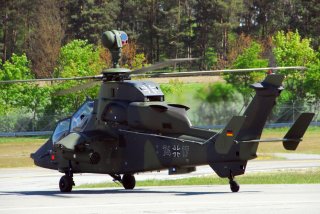The Army is Still Gunning for a New Stealth Helicopter
Engineering helicopters to achieve a stealthier operating performance involves engineering helicopter platforms to “hide and get lost within the radar clutter.”
Here's What You Need to Remember: Of course, stealthier performance optimizes an element of surprise and positions advanced helicopters, such as those now being developed for FVL, to much more effectively conduct forward reconnaissance and attack operations with less vulnerability to enemy fire.
The U.S. Army and academia are pushing the envelope of technological possibility to engineer the quietest, stealthiest helicopter ever to exist.
The U.S. Army Combat Capabilities Development Command (DEVCOM) and the Army Research Laboratory, Uber and the University of Texas at Austin are working together to develop several interoperating small, distributed rotors which generate a much different acoustic signature than existing helicopters.
“The basic idea is that smaller rotors have different sound signatures than larger conventional rotors because the sounds are created by different physical mechanisms. A conventional rotor’s noise comes from thickness noise, where the air is displaced by the rotors, and loading noise from the lift and drag forces of the air as it flows over the rotor blade,” an essay in the NewAtlas about the effort writes.
The idea is to use electric vertical take off and landing technology along with distributed rotor blades to achieve quiet lift and aerodynamic flight, the essay in New Atlas describes. Citing an interesting research paper from the U.S. Army Research Laboratory and the University of Austin, Texas, the essay explained that ongoing scientific experiments are looking at the acoustic characteristics of two and four-bladed rotors in hover mode. The research also examined other technical areas such as rotor blade thickness, loading and what’s called broadband noise.
Interestingly, it would not be at all surprising if any of the current research and experimentation drew upon innovations being harnessed for the Army’s fast-emerging Future Vertical Lift program. For example, one of the key technologies now being used by Sikorsky and Boeing with its now-in-development SB>Defiant Future Long Range Assault Aircraft design, a compound configuration using counter-rotating coaxial rotor blades to both increase speeds while reducing vibrations to decrease the acoustic and radar signature typically associated with helicopter flight. Bell Helicopter’s FLRAA offering, the V280 Valor, is also built with a mind to optimizing stealth.
Engineering helicopters to achieve a stealthier operating performance, Army Future Vertical Lift Cross Functional Team Director Maj. Gen. Wally Rugen told me in an interview, involves engineering helicopter platforms to “hide and get lost within the radar clutter.”
Both Sikorsky-Lockheed and Bell’s Future Attack Reconnaissance Aircraft also visibly incorporate stealth characteristics such as an internal weapons bay or extending firing pylon and a smooth. They also feature a rounded fuselage blended into the rotor blade structure with fewer sharp angles, protruding structures or edges more likely to generate a return signal to enemy radar.
Of course, stealthier performance optimizes an element of surprise and positions advanced helicopters, such as those now being developed for FVL, to much more effectively conduct forward reconnaissance and attack operations with less vulnerability to enemy fire.
Kris Osborn is the defense editor for the National Interest. Osborn previously served at the Pentagon as a Highly Qualified Expert with the Office of the Assistant Secretary of the Army—Acquisition, Logistics & Technology. Osborn has also worked as an anchor and on-air military specialist at national TV networks. He has appeared as a guest military expert on Fox News, MSNBC, The Military Channel, and The History Channel. He also has a Masters Degree in Comparative Literature from Columbia University.
Image: Wikipedia.

